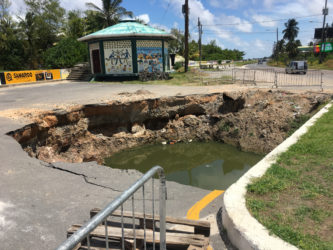Work on the sinkhole on the Seawall Road near the head of Vlissingen Road is expected to begin by next week, according to Chief Works Officer Geoffrey Vaughn.
Speaking with Stabroek News yesterday, Vaughn confirmed that the contract was awarded to Collin Talbot Construction Ser-vices and work is slated to begin in the first week of March.

Vaugh had earlier explained that $142 million have been set aside for the repairs to underlying pipes and the replacement of the road.
“We need to replace several pipes that are under the road around the area and a provisional sum is in the bill in case of added works when the whole surface has been opened up,” he had said, while stating that when the workers actually get under the road they might discover that the damage was more severe that they had initially thought.
As such, he had noted that when the work starts, the area from Queen Street to Vlissingen Road will be closed off and traffic travelling west along the Kitty Public Road will have to divert along Queen Street and exit David Street.
“As soon as the work starts, then the area will be closed off and we want to complete the work in the fastest of time because we want to have people using the road again as quickly as possible,” he said, while pointing out that the work will be done two parts. The first part will see the Kitty Public Road closed off while the second part will see the junction at Cari-festa Avenue, Rupert Craig Highway and Vlissingen Road closed off.
He also confirmed that the work could take as much as six months to be completed but they could wrap up well before that since the full extent of the job will not be known until the engineers get under the ground.
While it was reported that the work was being done with the Mayor and City Council collaborating with the Ministry of Public Infrastructure (MPI), Vaughn explained that the City Council was just on the committee.
A small sinkhole had initially developed late in December and since then the MPI in collaboration with the M&CC had enlarged it in order to apply a temporary fix. One of the engineers on site had explained to Stabroek News that the depression in the road, which resulted in the formation of the sinkhole, was due to a galvanized pipe bursting and letting water under the road.
Because of the excess water interacting with the earth, the road caved in, causing a traffic hazard to persons who frequented the thoroughfare.
The temporary fix had been to the pipe in order to stop it from letting water into the road. However, a week after, a few more depressions appeared on the road, several feet away from the sinkhole, suggesting that the temporary fix was not addressing the main issue.




